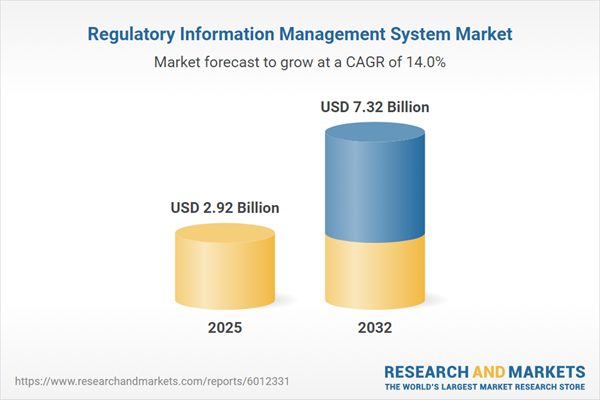Speak directly to the analyst to clarify any post sales queries you may have.
The regulatory information management system market is experiencing significant momentum as organizations across sectors navigate increasingly complex compliance demands. Advances in digital solutions, data centralization, and analytics are transforming how decision-makers develop resilient strategies for risk mitigation and sustainable growth.
Market Snapshot: Regulatory Information Management System Market Growth
The regulatory information management system market grew from USD 2.56 billion in 2024 to USD 2.92 billion in 2025. This sector is projected to expand at a CAGR of 13.99%, ultimately reaching USD 7.32 billion by 2032. Market growth is propelled by rising regulatory complexity, adoption of advanced analytics, and increasing demand for centralized data across highly regulated industries. These developments are driving investments in integrated systems that deliver end-to-end oversight, transparency, and real-time collaboration capabilities for global organizations.
Scope & Segmentation
This research delivers a thorough analysis of the regulatory information management market landscape across product components, deployment strategies, organization types, end users, applications, regions, and key vendors.
- Component
- Implementation Services
- Support Services
- Pharmacovigilance Software
- Regulatory Information Management Software
- Deployment Mode
- Hybrid Cloud
- Private Cloud
- Public Cloud
- On Premise
- Organization Size
- Large Enterprises
- Small & Medium Enterprises
- End User
- Chemicals
- Food & Beverage
- Government
- Healthcare
- Application
- Document Management (Archiving, Submission Management)
- Regulatory Submission (Common Technical Document, New Drug Application)
- Safety Management (Adverse Event Reporting, Signal Detection)
- Regions
- Americas (including North America, Latin America)
- Europe, Middle East & Africa (Europe, Middle East, Africa)
- Asia-Pacific
- Key Companies
- Veeva Systems Inc.
- IQVIA Holdings Inc.
- Oracle Corporation
- Dassault Systèmes SE
- PTC Inc.
- MasterControl Inc.
- ArisGlobal LLC
- Extedo GmbH
- Ennov SAS
- PharmaLex GmbH
Key Takeaways for Regulatory Information Management
- Centralized regulatory data enhances predictive analytics, allowing leaders to proactively address compliance changes and allocate resources more efficiently.
- Cloud-based and hybrid deployment models offer flexibility and scalability for organizations operating across multiple jurisdictions, supporting global collaboration and streamlined submissions.
- Technological advancements, such as AI and process automation, reduce manual errors and support faster time-to-market while improving risk management for complex regulatory environments.
- Sector-specific requirements among end users—including healthcare, chemicals, and government—shape distinct adoption patterns, making tailored platform selection and configuration essential.
- Leading vendors are prioritizing integrated suites and outcome-oriented services, fostering customer success through training, change management, and continuous operational support.
Tariff Impact on Compliance and Supply Chains
The introduction of new United States tariffs in 2025 has elevated the importance of agile supply chain structures and regulatory reporting. Companies are diversifying supplier networks and increasing cross-functional collaboration to ensure traceable documentation and compliance with evolving import costs. Advanced analytics and tariff management modules within RIM systems now play a pivotal role in scenario planning and risk mitigation strategies.
Methodology & Data Sources
This research integrates primary interviews with industry leaders, regulatory experts, and technology strategists, supported by secondary analysis of filings and industry publications. Data triangulation and peer-reviewed quality assurance steps underpin robust insights across segments and geographies.
Why This Report Matters for Senior Decision-Makers
- Enables informed strategic investments in regulatory platforms and data infrastructure for sustainable compliance and operational agility.
- Highlights major technology and regional trends, helping leaders identify opportunity areas and benchmark against best-in-class adoption models.
Conclusion
The regulatory information management system market is evolving as innovation and compliance priorities intersect. Senior decision-makers can leverage this report to adopt forward-looking strategies that enhance both compliance outcomes and long-term business value.
Additional Product Information:
- Purchase of this report includes 1 year online access with quarterly updates.
- This report can be updated on request. Please contact our Customer Experience team using the Ask a Question widget on our website.
Table of Contents
3. Executive Summary
4. Market Overview
7. Cumulative Impact of Artificial Intelligence 2025
Companies Mentioned
The companies profiled in this Regulatory Information Management System market report include:- Veeva Systems Inc.
- IQVIA Holdings Inc.
- Oracle Corporation
- Dassault Systèmes SE
- PTC Inc.
- MasterControl Inc.
- ArisGlobal LLC
- Extedo GmbH
- Ennov SAS
- PharmaLex GmbH
Table Information
| Report Attribute | Details |
|---|---|
| No. of Pages | 190 |
| Published | October 2025 |
| Forecast Period | 2025 - 2032 |
| Estimated Market Value ( USD | $ 2.92 Billion |
| Forecasted Market Value ( USD | $ 7.32 Billion |
| Compound Annual Growth Rate | 13.9% |
| Regions Covered | Global |
| No. of Companies Mentioned | 11 |









